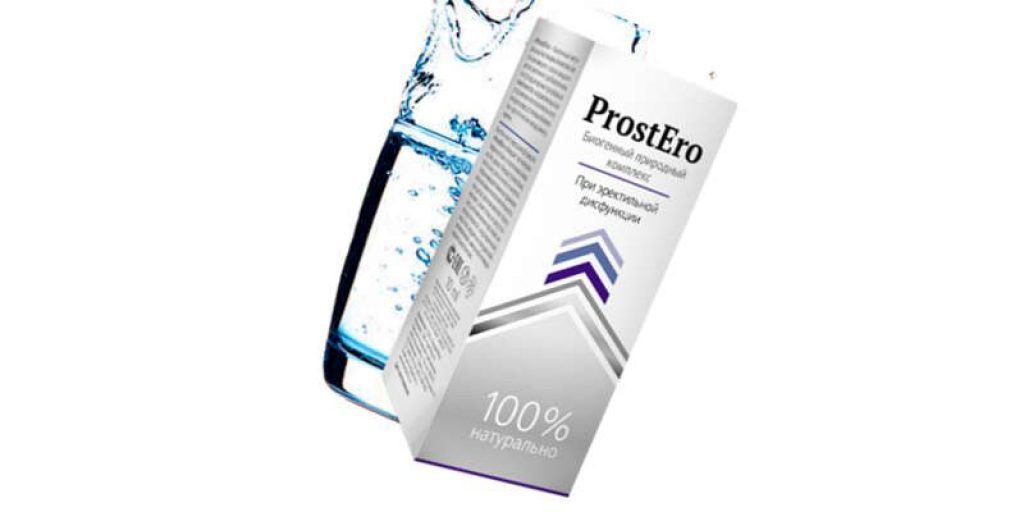Content
- The essence of the knee arthroplasty technique
- Indications for surgery
- Types of prostheses and associated surgical techniques
- What is Liquid Knee Replacement
- Contraindications
- Preparing for surgery
- Description of the surgical process
- Unipolar prosthetics
- Total prosthetics
- Rules to follow during the recovery period
- What awaits the patient after the operation
- Pain relief after surgery
- Rehabilitation program
- Terms of rehabilitation
- Possible complications and consequences
- Knee replacement cost
- Is it possible to have knee arthroplasty under a quota, compulsory medical insurance policy?
- Knee Replacement Videos
Endoprosthetics is the replacement of parts or a whole knee joint for artificial implants. Made of hypoallergenic materials, implanted parts successfully replace natural tissues and help restore limb mobility. The cost of the operation mostly depends on the cost of the endoprosthesis.
The essence of the knee arthroplasty technique
The knee joint is the largest in the human body. Its functionality provides upright posture. The wear of the joint capsule occurs under natural stress, for traumatic or pathological reasons.
Knee arthroplasty, the price of which depends on many conditions, is a technically difficult intervention. In case of damage to one area of the articular capsule, unipolar prosthetics or replacement of one injured section is performed. In the case of replacement of the entire articular apparatus, complete or total prosthetics are performed.
During the operation, the surgeon removes damaged bone fragments and remnants of deformed cartilage. In their place, artificial implants are installed. After complete healing, the patient returns to the normal rhythm of life.
Indications for surgery
The main indication for knee replacement is pain.
Total knee arthroplasty (TCA) is performed if the articular cartilage is destroyed as a result of:
- osteoarthritis;
- rheumatoid, inflammatory arthritis;
- post-traumatic degenerative joint disease or osteonecrosis (joint collapse with destruction of cartilage)
Damage to the synovial joint, one or more of the 3 sections (lateral, medial, patellofemoral), can result from a variety of pathological conditions. More than 95% of knee replacements are performed for osteoarthritis. In patients with osteoarthritis, TCA is indicated for the relief of severe knee pain that does not respond to conservative treatment.
Before moving on to TCA, a versatile non-surgical treatment regimen should be tried. The effectiveness of nonsurgical intervention, even with advanced osteoarthritis, is confirmed by clinical trials and is suitable for patients who wish to avoid or postpone surgery or for patients who are contraindicated operation.
Types of prostheses and associated surgical techniques
The knee joints used for replacement are made of metal and plastic. The damaged femur and tibia are replaced with metal alloy parts. The high-density plastic replaces the cartilage on the lower leg and patella components during endoprosthetics. The cost of the operation depends on the complexity of the prosthesis. The selection of the required prosthesis depends on the individual characteristics of the joint structure and the stage of deformity.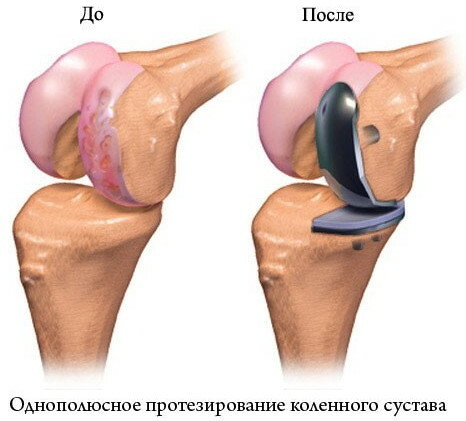
Types of prostheses:
| Single-sided | It is a movable platform with a polyethylene liner sliding along the tibial plateau (tibia). The liner plays the role of a meniscus and allows you to accurately reproduce the trajectory of movement. |
| Articulated | It is installed during revision surgery (complete prosthetics). The total hinge implant replaces the entire articular area. A technical feature includes the presence of mechanical stabilizers. |
| Associated endoprosthesis | Prepared on the basis of computer modeling. Fine navigation with a computer allows fine manipulations, taking into account the level of bone resection. |
The service life of prostheses is at least 10 years. In 80% of cases, new joints are suitable for work for more than 20 years, depending on the patient's state of health and physical activity.
What is Liquid Knee Replacement
Liquid prosthetics or the introduction of an intra-articular prosthesis of the synovial fluid is an injection under the control of ultrasound. A sterile solution based on hyaluronic acid or polymer acts as an intra-articular fluid. It acts as a lubricant that allows the bones to move smoothly relative to each other.
The operation is performed in the presence of degenerative-dystrophic diseases of the cartilage tissues of the articular surface. The greatest effect of liquid prosthetics is achieved in the early stages of arthrosis. In this case, the cartilage tissue is restored to a healthy state.
In severe cases, intra-articular fluid administration slows down the destruction of bone and cartilage tissue and restores the natural amount of synovial fluid.
The use of liquid prosthetics is not designed for a long-term effect, but it allows you to minimize knee pain and prolong the life of the damaged joint before surgery.
Contraindications
Total knee replacement is considered for patients of any age, if the diagnosis of osteoarthritis is confirmed clinically and radiographically, the patient continues to experience moderate to severe pain, the quality of life is deteriorating, despite a long course of non-surgical treatment, and there are no contraindications exists.
Referral to specialists before the disease reaches an extremely advanced stage leads to better results. Arthroplasty is beneficial, but it is a serious surgical procedure with possible complications and the risk of failure.
Absolute contraindications for arthroplasty include active sepsis of the knee joint and severe, untreated or incurable peripheral arterial disease.
Surgical treatment of the knee joint is contraindicated in the following cases:
- the presence of diseases of the cardiovascular system;
- bronchial-pulmonary diseases in the stage of decompensation;
- focal purulent infections (carious process on the teeth, chronic sinusitis, tonsillitis, otitis media, pustular skin lesions);
- recorded mental or neuromuscular disorders;
- immaturity of the bones of the skeleton;
- lack of the ability to move;
- the presence of polyallergy;
- acute vascular diseases of the lower extremities (thrombophlebitis, thromboembolism).
Patient-related factors that affect the success of knee replacement include obesity, comorbidities and unrealistic expectations of patients regarding complete pain relief and the functioning of the joints.
Among the relative contraindications noted:
- the presence of cancer;
- ulcerative and erosive lesions of the gastrointestinal tract;
- anemic condition (hemoglobin less than 100 g / l);
- chronic diseases of a somatic nature;
- liver failure;
- hormonal osteopathy;
- obesity 3-4 degrees.
Preparing for surgery
Knee arthroplasty (the price fluctuates slightly in the regions) includes replacement all structures of the joint, or some, therefore, an initial general examination by the treating person is necessary doctor. At this stage, possible health problems are identified. Completion of dental treatment is a prerequisite for preparation. It is unacceptable for microbial flora to enter the systemic circulation and infection of the knee joint.
The list of required studies includes:
- X-ray pictures of the joint with a description;
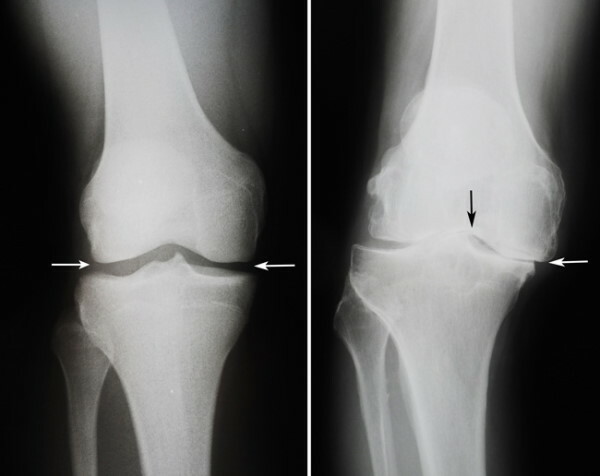
- conclusions of the therapist and dentist;
- conclusion of a gynecologist and urologist;
- a general blood test, including a study for hemoglobin and blood cell composition;
- general urine analysis;
- coagulogram with prothrombin index, fibrinogen, APTT and orthophenanthroline test;
- biochemical blood test for glucose, transaminases, total protein, bilirubin, urea, creatinine and determination of the prothrombin index;
- analysis for HIV, hepatitis B, C and syphilis;
- analysis of feces for worm eggs;
- fluorography;
- electrocardiogram with a conclusion;
- scanning of veins and arteries of the lower extremities and consultation of a vascular surgeon;
- fibrogastroduodenoscopy.
In case of identified diseases, the conclusion of an infectious disease specialist, endocrinologist, neuropathologist, ophthalmologist, rheumatologist, urologist, dermatologist or phthisiatrician will be required.
With family and friends, you should discuss issues of assistance during the implementation of hygiene procedures, cooking and doing household chores for several postoperative weeks.
The dwelling should also be prepared: to ensure the safety of movement and eliminate the risks of possible falls.
Before the operation, work is performed on preliminary drug preparation of the patient for general anesthesia with the help of a sedative, narcotic analgesic and antihistamines, a cleansing is done enema. Antibacterial therapy is carried out as a prophylaxis, a cleansing enema. Immediately before the operation, food and liquids should be avoided after midnight before the date of the operation.
Description of the surgical process
Endoprosthetics of the knee joint (the price depends on the type of operation) in a standard situation takes 1.5-2 hours. In the process of opening the capsule of the joint capsule, the surface areas of the bone tissue are exposed. This is followed by the removal of part of the bone and the inner surface of the patella. The ligamentous apparatus is not affected unnecessarily. To improve the functioning of the joint, the surgeon strengthens the ligaments.
Artificial pads are placed on the finished bone surfaces. Their configuration mimics the shape of the knee joint to ensure full functioning.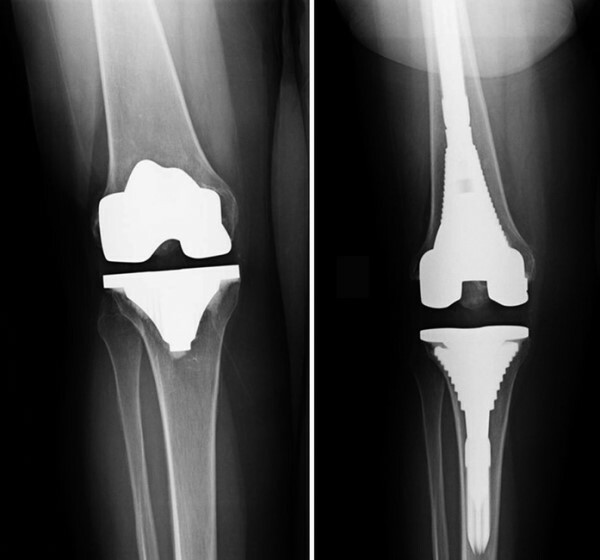
At the end of the operation, before suturing, drainage is installed to drain blood and exudate from the wound. In addition to basic manipulations, the doctor performs work to replenish blood loss and prevent possible infection.
Unipolar prosthetics
One-sided arthroplasty is performed in case of disorders of one of the parts of the joint. The operation is performed under general anesthesia.
An incision is made in the front of the knee joint. The damaged parts are removed and the femur and tibia are prepared using special templates.
Trial prostheses are placed on the prepared bone surfaces to monitor the expected result. Only after this is the installation and strengthening of the final components of the prosthesis carried out.
Single-condom prostheses replace the cartilaginous tissue of the injured section without affecting the ligamentous apparatus and without requiring the removal of bone tissue. Such prosthetics preserves the natural structure of bone tissue, ligaments and cartilage. At the same time, the natural geometric relationships are preserved, the difference in the length of the limbs is minimized.
The required shock absorber and the sliding plane between the base parts of the prosthesis are made of synthetic polyethylene. The prosthesis itself is made of high quality metal alloy.
Total prosthetics
In this case, a complete replacement of the damaged articular part with an artificial implant is performed.
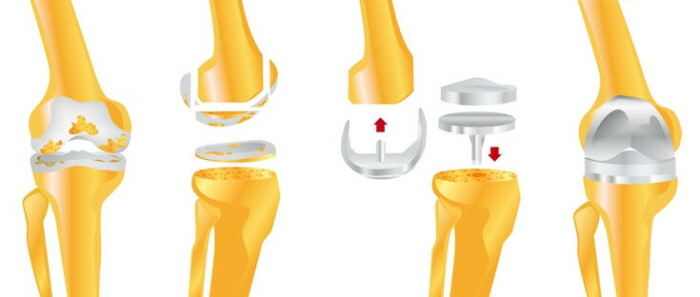
The surgeon, after layer-by-layer immersion in soft tissues, exposes the articular region. Bone tissue is sawn off according to the deformation line and articular implants are placed on the prepared areas. After installation, the surgical field is cleaned and processed, and then layer-by-layer suture is applied.
Rules to follow during the recovery period
In the immediate postoperative period, the patient may feel that progress is insignificant, but this is not the case, since the recovery process is long.
Compliance with the rules during rehabilitation increases the chance of a successful outcome of surgical treatment.
- Do not remove the bandages on your own or earlier than required. Exposing the surgical incision too early can lead to infection of the surgical site. intervention, and this can potentially lead to infection of the knee endoprosthesis, which is a serious complication.
- Swelling after knee surgery can persist for 3 to 6 months. Ice packs are recommended to reduce inflammation and pain. They are used 3-4 times a day for about 10-20 minutes during the first few days. After the initial swelling has subsided, ice and heat are alternated to relax the muscles and relieve stiffness.
- Do not put unnecessary stress on the knee. You cannot lift weights. When turning the body, you should turn around with the whole body, and not twist the knee.
- Health should be monitored. Reduce tobacco use or quit smoking. Smoking constricts blood vessels, which slows down the healing process. Avoid drinking alcohol if you are taking blood thinners or pain relievers. Maintain weight as the extra pounds put more pressure on the knee and can slow down recovery. Strengthen leg muscles to improve overall blood flow. Engage in low-impact activities, such as walking, swimming, or cycling, if permitted by your doctor.
- Do not perform other surgical procedures during recovery, such as dental procedures, on the bladder or intestines, as they can lead to infection of the healing knee.
- Avoid getting water on the operating area until the skin is completely healed.
- A balanced diet high in iron speeds up the process of tissue repair and muscle strength.
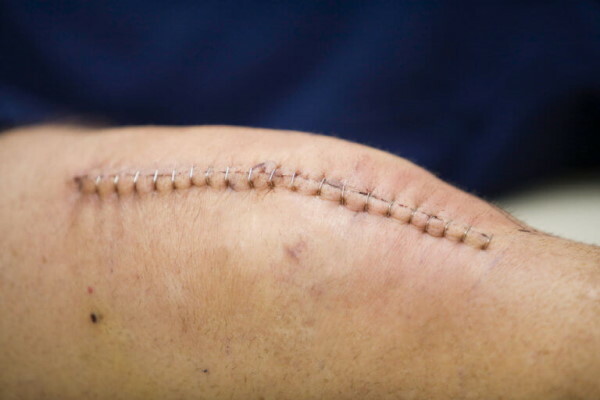
Activity is the key to successful rehabilitation. Gradually, you should increase the duration of walking and carry out the necessary exercises.
What awaits the patient after the operation
The recovery process is carried out under the supervision of a physician. The duration of rehabilitation depends on the complexity of the prosthetics performed and the general state of health.
Most of the pain will go away one year after surgery. However, there may still be swelling in the lower leg and foot, as well as discomfort when going up and down stairs or sitting for too long in one position. For better recovery, it is important to be physically active and maintain a healthy weight.
You can resume low-intensity activities such as volleyball or softball. Do not engage in high-intensity activities such as football, tennis, or basketball.
Pain relief after surgery
Pain relievers are used immediately after the operation. They are injected through the epidural space in the spine or intravenously. Once you start eating your normal meals, the catheters are removed and pain relievers are given for oral administration. Systemic non-steroidal anti-inflammatory drugs based on Ibuprofen or Paracetamol are more commonly used.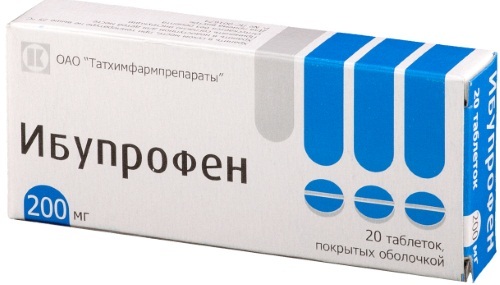
Taking painkillers is canceled 1-2 weeks after the operation, since by this time the postoperative pain disappears, but this does not mean that the knee has completely healed.
Rehabilitation program
Recovery measures begin from the first day after surgery. Classes include physical therapy (exercise therapy), massage and physical methods.
- Exercise therapy includes performing movements in the ankle joint, exercises on the quadriceps muscle of the thigh, lifting the extended leg and flexion exercises. The complex of physical exercises is complemented by the ascents and descents of the stairs.
- The massage is carried out symmetrically on both limbs. The course of treatment is 7-10 procedures and is aimed at restoring the blood supply to the tissues.
- Physical therapies are aimed at reducing pain and swelling, preventing inflammation, and improving trophism and soft tissue metabolism. Local cryotherapy, magnetotherapy, and ultraviolet radiation are used more often. The standard course is 5-10 lessons.
Terms of rehabilitation
The average recovery time for the usual way of life takes from 3 weeks to 6 months.
Activation of movements begins from the first day after the operation. The patient is allowed to sit down on his own from the second day. From the same time, you should begin to perform exercises for static loads.
Dosed walking with support is carried out from the third day. Removal of stitches with successful healing of the skin is carried out for 10-12 days. Then the patient is discharged home to continue rehabilitation activities.
Possible complications and consequences
Knee arthroplasty, the price of which depends on the age of the patient and the method of prosthetics, is considered a low-risk operation.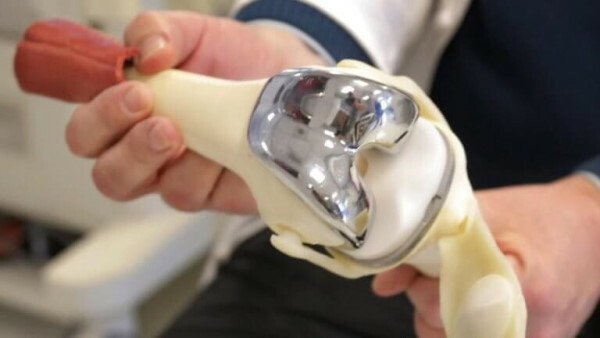
Possible postoperative complications:
| Blood clots (thrombosis) | Sometimes clots travel through veins to the heart and lungs (pulmonary embolism). For this, blood-thinning drugs are prescribed, it is suggested to wear compression cuffs and do exercises for the legs. |
| Adhesions limiting joint flexion | Any incision can form adhesions or scar tissue that limits flexion. With large adhesions (arthrofibrosis), a few weeks or months after the operation, special manipulations are performed to destroy the scar tissue. |
| Incorrect placement or selection of implant size | Misalignment is not a common complication, but can occur when incisions are made at the wrong angle. The selection of the wrong implants ranges from too large a femoral component to too thick or thin inserts (spacers). Any of these can cause postoperative pain, movement problems. |
| Infection | Infections during surgery are rare and include primary, late, or even superficial infection. The risk of infection is increased in patients with rheumatoid arthritis or diabetes, in people who have been took cortisone, whose joint was previously infected, who had an infection in another during the operation body parts. |
| Looseness of the implant | Detachment of the implant from the bone is the most serious potential problem in the long term. Looseness can be the result of infection, improper technique during surgery, poor condition bone damage and softening due to osteoporosis or rheumatoid arthritis, obesity or excessive strength. |
| Allergic or other reactions | In rare cases, an allergic reaction to the metal used to replace the knee joint is possible. No allergy to plastic components has ever been reported. |
| Nerve damage | In rare cases, nerve damage can occur during knee replacement. The chances are slim, but when this type of damage occurs, the affected nerve usually heals in 6-12 months. Often, skin numbness in the front of the knee and on the outside of the incision occurs when a branch of a small nerve is cut during surgery. |
Myocardial infarction and stroke occur in 0.5% of cases. However, the presence of chronic diseases increases the risk of complications. Serious consequences in the form of infection are observed in less than 2% of cases.
Knee replacement cost
The average cost ranges from 150-300 thousand. rubles. The difference in price depends on the degree of joint deformation and the doctor's choice of the prosthetic method.
Is it possible to have knee arthroplasty under a quota, compulsory medical insurance policy?
For treatment under the compulsory medical insurance policy, you will need to contact a medical institution with a package of documents: a passport, an compulsory medical insurance policy and an insurance policy. Initially, an initial examination is carried out, after which a list of queuing up for a quota is filled in. After receiving the quota, you should again go to the medical institution, where the date of the operation will be set.
Knee arthroplasty is a complex, high-tech operation, therefore the price is high. The operation requires great professionalism of the doctor, on which the further recovery process largely depends.
Knee Replacement Videos
Knee arthroplasty:


